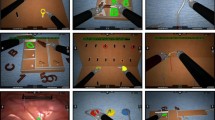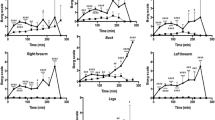Abstract
Background/Aim
Training in robot-assisted surgery focusses mainly on technical skills and instrument use. Training in optimal ergonomics during robotic surgery is often lacking, while improved ergonomics can be one of the key advantages of robot-assisted surgery. Therefore, the aim of this study was to assess whether a brief explanation on ergonomics of the console can improve body posture and performance.
Methods
A comparative study was performed with 26 surgical interns and residents using the da Vinci skills simulator (Intuitive Surgical, Sunnyvale, CA). The intervention group received a compact instruction on ergonomic settings and coaching on clutch usage, while the control group received standard instructions for usage of the system. Participants performed two sets of five exercises. Analysis was performed on ergonomic score (RULA) and performance scores provided by the simulator. Mental and physical load scores (NASA-TLX and LED score) were also registered.
Results
The intervention group performed better in the clutch-oriented exercises, displaying less unnecessary movement and smaller deviation from the neutral position of the hands. The intervention group also scored significantly better on the RULA ergonomic score in both the exercises. No differences in overall performance scores and subjective scores were detected.
Conclusion
The benefits of a brief instruction on ergonomics for novices are clear in this study. A single session of coaching and instruction leads to better ergonomic scores. The control group showed often inadequate ergonomic scores. No significant differences were found regarding physical discomfort, mental task load and overall performance scores.












Similar content being viewed by others
References
Broeders IAMJ (2014) Robotics: the next step?. Best Pract Res Clin Gastroenterol 28(1):225–232
Raza SJ, Froghi S, Chowriappa A, Ahmed K, Field E, Stegemann AP et al (2014) Construct validation of the key components of fundamental skills of robotic surgery (FSRS) curriculum: a multi-institution prospective study. J Surg Educ 71(3):316–324
Sealed Envelope Ltd. Create a blocked randomisation list [Internet]. 2016 [cited 2016 Apr 5]. https://www.sealedenvelope.com/simple-randomiser/v1/lists
Yang K, Perez M, Perrenot C, Hubert N, Felblinger J, Hubert J (2016) A new system for evaluation of armrest use in robotic surgery and validation of a new ergonomic concept: armrest load. Int J Med Robot Comput Assist Surg 12:604–612
Mcatamney L, Corlett EN (1993) RULA: a survey method for the investigation of world-related upper limb disorders. Appl Ergon 24(2):91–99
Corlett EN, Bishop RP (1976) A technique for assessing postural discomfort. Ergonomics 19(2):175–182
Hart SG (2006) NASA-task load index (NASA-TLX); 20 years later. Hum Factors Ergon Soc Annu Meet 50:904–908
Rubio S, Diaz E, Martin J, Puente J (2004) Evaluation of subjective mental workload: a comparison of SWAT, NASA-TLX, and workload profile methods. Appl Psychol 53:61–86
Van Der Schatte Olivier RH, Van’t Hullenaar CDP, Ruurda JP, Broeders IAMJ (2009) Ergonomics, user comfort, and performance in standard and robot-assisted laparoscopic surgery. Surg Endosc 23(6):1365–1371
Mohammad Mirbod S, Yoshida H, Miyamoto K, Miyashita K, Inaba R, Iwata H (1995) Subjective complaints in orthopedists and general surgeons. Int Arch Occup Environ Health 67(3):179–186
Sari V, Nieboer TE, Vierhout ME, Stegeman DF, Kluivers KB (2010) The operation room as a hostile environment for surgeons: physical complaints during and after laparoscopy. Minim Invasive Ther Allied Technol 19(2):105–109
Auerbach JD, Weidner ZD, Milby AH, Diab M, Lonner BS (2011) Musculoskeletal disorders among spine surgeons: results of a survey of the Scoliosis Research Society membership. Spine 36(26):E1715–1721
Dalager T, Søgaard K, Jensen PT (2016) Musculoskeletal pain among surgeons performing minimally invasive surgery: a systematic review. Surg Endosc 31:516–526
Tzeng Y-S, Chen S-G, Chen T-M (2012) Herniation of the cervical disk in plastic surgeons. Ann Plast Surg 69(6):672–674
Acknowledgements
Many thanks to the residents and interns at the Department of Surgery for their cooperation in this research project.
Author information
Authors and Affiliations
Corresponding author
Ethics declarations
Disclosures
Broeders is a Proctor at Intuitive Surgery. Van’t Hullenaar, Mertens, and Ruurda have no conflicts of interest or financial ties to disclose.
Electronic supplementary material
Below is the link to the electronic supplementary material.



Rights and permissions
About this article
Cite this article
Van’t Hullenaar, C.D.P., Mertens, A.C., Ruurda, J.P. et al. Validation of ergonomic instructions in robot-assisted surgery simulator training. Surg Endosc 32, 2533–2540 (2018). https://doi.org/10.1007/s00464-017-5959-1
Received:
Accepted:
Published:
Issue Date:
DOI: https://doi.org/10.1007/s00464-017-5959-1




